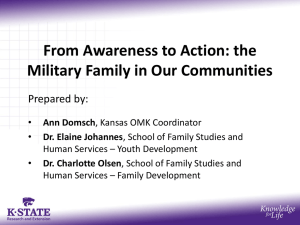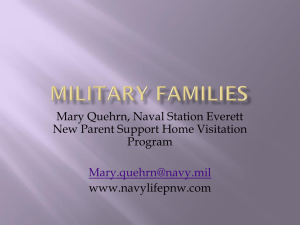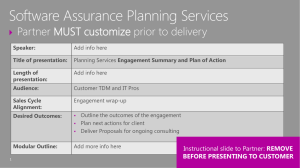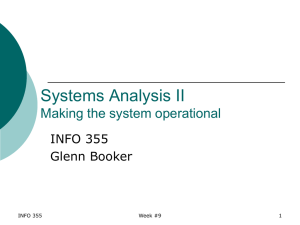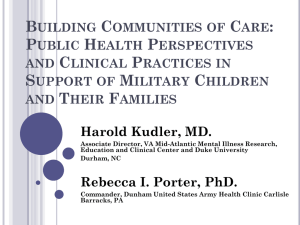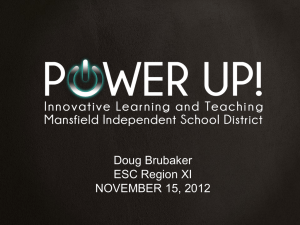A Primary Care Approach To Meeting the Unique Needs of Military
advertisement
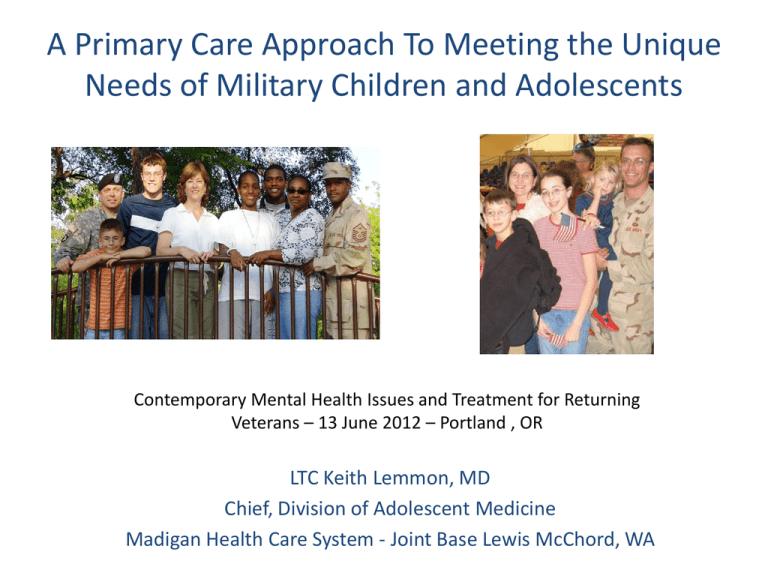
A Primary Care Approach To Meeting the Unique Needs of Military Children and Adolescents Contemporary Mental Health Issues and Treatment for Returning Veterans – 13 June 2012 – Portland , OR LTC Keith Lemmon, MD Chief, Division of Adolescent Medicine Madigan Health Care System - Joint Base Lewis McChord, WA Department of Defense Disclaimer • The opinions or assertions contained in this presentation are the private views of the presenter and are not to be construed as official or as reflecting the views of the Department of Defense Objectives • Background • Summarize what is currently known about the effects of military life and culture on our children and adolescents • Review findings from the recent Workshop on the Scientific Study of Military Children held in Washington D.C. in Nov 2011 • Hear from real military kids • Discuss and distribute the Military Youth Deployment Support Video Program • Discuss Madigan Healthcare System’s innovative Military Adolescent School Based Health Initiative (MASBHI) • Review Resources The Issues • When warriors are assured that their family is being cared for by the community they are fighting to protect, they are able to more clearly focus on the critical combat and sustainment operations they are performing far from home. • It is likely that children who grow up in a well functioning and emotionally connected military family are more likely to consider military service as a viable career choice. The Need • Approximately 43% of service members have children • 1.5 million Active Duty, National Guard and Reserve service members have been deployed and of those 1/3rd have deployed more than once • Approximately 2 million children have experienced a parental deployment since the beginning of OEF and OIF • Approximately 200,000 children currently have one parent deployed. Answering Mandates • Army Family Covenant • DoD Mental Health Task Force Recommendations • American Psychological Association Task Force Recommendations • American Academy of Pediatrics Prioritized Legislative Recommendation The Challenges • Child advocacy is difficult due to lack of empowerment and prioritization of children’s issues • Child mental health care provider shortage • Military youth resilience – May be overstated and used as a reason to avoid prioritizing research and programming • Youth research and programming is difficult – Due to need to approach youth in developmentally appropriate way – basically need 3 approaches (preschool, elementary, teen) vs. one size often fits all for adult issues Current Research • The impetus of wars have traditionally brought about great advances in medical knowledge - this war will be particularly known for it's advances in how to deal with psychological trauma • This will be a long term issue as service members and their families heal from the stresses and secondary effects of war Current Research • Available research suggests that current deployments are stressing military families. • Chartrand M et al. Effect of Parents Wartime Deployment on the Behavior of Young Children in Military Families. Archive of Pediatric and Adolescent Medicine; 162 (11); 1009-1014. • Barnes V, et al. – Perceived Stress, Heart Rate and Blood Pressure among Adolescents with Family Members Deployed in Operation Iraqi Freedom – Military Medicine Jan 2006 • Rentz E. Danielle, et al. – Effect of Deployment on the Occurance of Child Maltreatment in Military and Nonmilitary Families - American Journal of Epidemiology Feb 2007 Current Research • Gibbs Deborah, et al –Child Maltreatment in Enlisted Soldiers’ Families During CombatRelated Deployments - Journal of the American Medical Association – August 2007 • Flake Eric, et al – The Psychosocial Effect of Deployment on Children – Journal of Developmental and Behavioral Pediatrics – Aug 2009. • Gorman Greg, et al – Wartime Military Deployment and Increased Pediatric Mental Health and Behavioral Health Complaints – Pediatrics - Nov 2010. • Reed Sarah, et al – Adolescent Well Being in WA State Military Families, American Journal of Public Health, July 2011. Special Considerations for Reserve/National Guard • Suddenly Military • May remain near family support but not have military installation support • Feelings of isolation • Family benefits different from AD • Tricare issues Workshop on the Scientific Study of Military Children – 16-18 Nov 2011 • Sponsoring organizations included Blue Star Families, The Center for a New American Security, Joining Forces, The Military Child Education Coalition, Tufts University, and USUHS. • Goals : 1. To chart a scientific research agenda by proposing a science base for services for military children and indicating what needs to be known about the effectiveness of existing programs for military children. 2. To propose an implementation plan by creating the political will to support the proposed research agenda, by encouraging researchers and students to focus on military children, and by interesting funding agencies and private foundations to support research on military children and program evaluations. www.militarychildren.cna.org View a Clip From Military Youth Coping with Separation Hear about military kids’ lives in their own words View a Clip From Military Youth Coping with Separation Hear about military kids’ lives in their own words Unique Aspects of Military Child/Adolescent Culture • Military youth live the concept of service and sacrifice every bit as much as their military parent • Expected to take on more advanced family roles when family members are away • May live in environment where parent is absent – physically or emotionally The Military Child and Adolescent Deployment Support Video Program View the videos at : www.aap.org/sections/uniformedservices/deployment/index.html MYDSVP Distribution • Final distribution – 200,000 copies of the program • 61% Army, 12% Air Force, 11% DOD Civilian, 4% Marine Corps, 10% Navy, 2% other • Component – 67% Active Duty, 15 % National Guard, 12% Reserve, 6% other • Program has been requested by someone from every state in the country plus Guam, Puerto Rico, the Virgin Islands and multiple foreign countries via APO/FPO • Top states include TX – 13.5%, CA-8.4%, NY-5.9%, WA-5.8%, VA-4.9%, NC-4.6%, AE (Armed Forces Europe, Canada, Middle East, Africa) – 3.4% Military Adolescent School Based Health Initiative (MASBHI) • A student centered clinic provided by the Madigan Health Care System’s Division of Adolescent Medicine • Provide comprehensive physical, behavioral, and emotional health services to military adolescents in a school based environment Why School Health • Providing health care to military adolescents in a hospital setting is suboptimal • Teens often have to miss most of a school day and parents most of a work day to come to the hospital • The no show rate for adolescent visits in hospital based clinic is high – recently 14% - often the highest in the hospital • National data shows that school based health programs improve quality of care as well as patient and parent satisfaction South Sound Military Students • 7810 Adolescents Age 12-18 enrolled to MHS • 6.8% map to the Steilacoom Historical School District • 20.3% map to the Clover Park School District • Other local districts with military populations include Tacoma 13.9%, Olympia 12.7%, Puyallup 9.9%, Lacey 9.8%, Spanaway 7.8%, and Yelm 6.3% Messages to the Community • What do I say to children whose parents are deployed or suffer an adverse outcome from military service? • What can I do to help military children? What to Say • Express appreciation for their personal service and sacrifice as well as that of their military family member • Encourage integration of their military values into their sense of identity • Asking for and accepting help is a sign of strength • Normalize experience What to do? • Listen and be prepared to connect them to community resources • Inform your community of their presence and their special culture and needs • Consider providing a forum to bring military youth together within the local community so that their sense of isolation can be mitigated • Be aware of where they are at in the deployment cycle and provide flexibility • Mitigate the impact of public opinion of the war on military children • Be aware that military children may present with manifestations of excessive stress in the form of somatization. • How do Military Youth Experience Injury, Post Traumatic Stress Disorder or Traumatic Brain Injury in Members of Their Family? Important Web Sites • AAP Military Youth Deployment Support Website – http://www.aap.org/sections/uniformedservic es/deployment/index.html • www.MilitaryKidsConnect.org (T2 – DCOE) • www.Afterdeployment.org • www.military-child.org (Military Child Education Coalition) User Centered Design o Exploratory Focus Groups: Pre-development • Deployment challenges, common concerns, use of resources, technology usage o Concept Testing: During development • Likes/dislikes, interest in activities, security and monitoring o Usability Testing: Ongoing • Ease of use How MilitaryKidsConnect Helps o o o o o o Peer-to-peer support between military youth. Normalize reactions to separation from parents. Teach realistic expectations for deployment. Minimize unknowns related to deployment cycle. Enhance learning between military youth. Inform parents of common behavioral responses at home. o Help educators understand military culture and common behavioral responses in school. Welcome Page 32 Website Activities • Message Board • Interactive Map • Videos • Coping/Inspirational Videos – Documentary style videos about how military youth coped with their parents’ deployment • Instructional Vignettes – Acted videos that introduce a common dilemma military youth will face while a parent is deployed. • Perspective Videos – Documentary style videos of families discussing what it was like during post deployment. Website Activities • • • • Games Deployment Daily Kids drop and drag scrapbook for younger kids Kids can complete during the deployment and share with parent when they come home as part of reintegration. Parent & Educator Resources • Parents and educators content: - E-library style for 1st version since emphasis has been on content for kids instead. - Parents can see the types of behaviors they can expect to see and some parenting tips. - Educators have similar types of information as parents with the inclusion of information on military life. Current Metrics Number of Visits • (Total = 37,610) – – – – Jan 18-Feb 20: 19,174 Feb 20-Mar 20: 5,978 Mar 20-Apr 15: 5,106 Apr 15-May 15: 7,631 # of page views 16000 14000 12000 10000 8000 6000 4000 2000 0 kids 36 tweens teens parents educators Ongoing Development o Improve parent-child interaction. o Increase focus on anxiety-related issues and coping strategies. o Focus on post-deployment. o More creative self-expression. o Add grief & loss, physical injury, PTSD modules. o Enhance Parent & Educator tracks. o More teen engagement. AfterDeployment.org 38 • If you want to honor a member of the military for their service and sacrifice, take exceptionally good care of their legacy, their children, while they are away doing the necessary work of the nation. • COL Elisabeth M. Stafford, MD, FAAP

